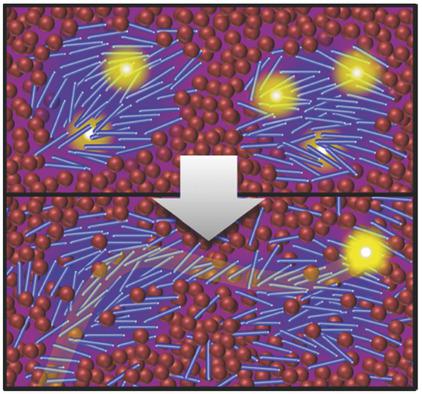当前位置:
X-MOL 学术
›
Adv. Energy Mater.
›
论文详情
Our official English website, www.x-mol.net, welcomes your feedback! (Note: you will need to create a separate account there.)
Mixed Domains Enhance Charge Generation and Extraction in Bulk‐Heterojunction Solar Cells with Small‐Molecule Donors
Advanced Energy Materials ( IF 27.8 ) Pub Date : 2018-03-24 , DOI: 10.1002/aenm.201702941 Obaid Alqahtani 1 , Maxime Babics 2 , Julien Gorenflot 2 , Victoria Savikhin 3, 4 , Thomas Ferron 1 , Ahmed H. Balawi 2 , Andreas Paulke 5 , Zhipeng Kan 2 , Michael Pope 1 , Andrew J. Clulow 6 , Jannic Wolf 7 , Paul L. Burn 6 , Ian R. Gentle 6 , Dieter Neher 5 , Michael F. Toney 4 , Frédéric Laquai 2 , Pierre M. Beaujuge 2, 7 , Brian A. Collins 1
Advanced Energy Materials ( IF 27.8 ) Pub Date : 2018-03-24 , DOI: 10.1002/aenm.201702941 Obaid Alqahtani 1 , Maxime Babics 2 , Julien Gorenflot 2 , Victoria Savikhin 3, 4 , Thomas Ferron 1 , Ahmed H. Balawi 2 , Andreas Paulke 5 , Zhipeng Kan 2 , Michael Pope 1 , Andrew J. Clulow 6 , Jannic Wolf 7 , Paul L. Burn 6 , Ian R. Gentle 6 , Dieter Neher 5 , Michael F. Toney 4 , Frédéric Laquai 2 , Pierre M. Beaujuge 2, 7 , Brian A. Collins 1
Affiliation

|
The interplay between nanomorphology and efficiency of polymer‐fullerene bulk‐heterojunction (BHJ) solar cells has been the subject of intense research, but the generality of these concepts for small‐molecule (SM) BHJs remains unclear. Here, the relation between performance; charge generation, recombination, and extraction dynamics; and nanomorphology achievable with two SM donors benzo[1,2‐b:4,5‐b]dithiophene‐pyrido[3,4‐b]‐pyrazine BDT(PPTh2)2, namely SM1 and SM2, differing by their side‐chains, are examined as a function of solution additive composition. The results show that the additive 1,8‐diiodooctane acts as a plasticizer in the blends, increases domain size, and promotes ordering/crystallinity. Surprisingly, the system with high domain purity (SM1) exhibits both poor exciton harvesting and severe charge trapping, alleviated only slightly with increased crystallinity. In contrast, the system consisting of mixed domains and lower crystallinity (SM2) shows both excellent exciton harvesting and low charge recombination losses. Importantly, the onset of large, pure crystallites in the latter (SM2) system reduces efficiency, pointing to possible differences in the ideal morphologies for SM‐based BHJ solar cells compared with polymer‐fullerene devices. In polymer‐based systems, tie chains between pure polymer crystals establish a continuous charge transport network, whereas SM‐based active layers may in some cases require mixed domains that enable both aggregation and charge percolation to the electrodes.
中文翻译:

混合域增强了具有小分子供体的体异质结太阳能电池中电荷的产生和提取。
聚合物-富勒烯本体-异质结(BHJ)太阳能电池的纳米形态与效率之间的相互作用一直是深入研究的主题,但对于小分子(SM)BHJ的这些概念的普遍性仍不清楚。在这里,性能之间的关系;电荷产生,重组和提取动力学;和两个SM供体苯并[1,2- b:4,5 - b ]二噻吩-吡啶并[3,4- b ]-吡嗪BDT(PPTh 2)2可实现纳米结构根据溶液添加剂组成的不同,对SM1和SM2进行了侧链区别,即SM1和SM2。结果表明,添加剂1,8-二碘辛烷在共混物中起增塑剂的作用,增加了畴尺寸,并促进了有序性/结晶性。出乎意料的是,具有高域纯度(SM1)的系统既表现出较弱的激子收割效果,又表现出严重的电荷俘获,仅随结晶度的增加而略有缓解。相反,由混合域和较低结晶度(SM2)组成的系统显示出优异的激子收割和低电荷重组损失。重要的是,后者(SM2)系统中大而纯的微晶的出现降低了效率,这表明与聚合物富勒烯装置相比,基于SM的BHJ太阳能电池的理想形态可能存在差异。在基于聚合物的系统中,
更新日期:2018-03-24
中文翻译:

混合域增强了具有小分子供体的体异质结太阳能电池中电荷的产生和提取。
聚合物-富勒烯本体-异质结(BHJ)太阳能电池的纳米形态与效率之间的相互作用一直是深入研究的主题,但对于小分子(SM)BHJ的这些概念的普遍性仍不清楚。在这里,性能之间的关系;电荷产生,重组和提取动力学;和两个SM供体苯并[1,2- b:4,5 - b ]二噻吩-吡啶并[3,4- b ]-吡嗪BDT(PPTh 2)2可实现纳米结构根据溶液添加剂组成的不同,对SM1和SM2进行了侧链区别,即SM1和SM2。结果表明,添加剂1,8-二碘辛烷在共混物中起增塑剂的作用,增加了畴尺寸,并促进了有序性/结晶性。出乎意料的是,具有高域纯度(SM1)的系统既表现出较弱的激子收割效果,又表现出严重的电荷俘获,仅随结晶度的增加而略有缓解。相反,由混合域和较低结晶度(SM2)组成的系统显示出优异的激子收割和低电荷重组损失。重要的是,后者(SM2)系统中大而纯的微晶的出现降低了效率,这表明与聚合物富勒烯装置相比,基于SM的BHJ太阳能电池的理想形态可能存在差异。在基于聚合物的系统中,

























 京公网安备 11010802027423号
京公网安备 11010802027423号